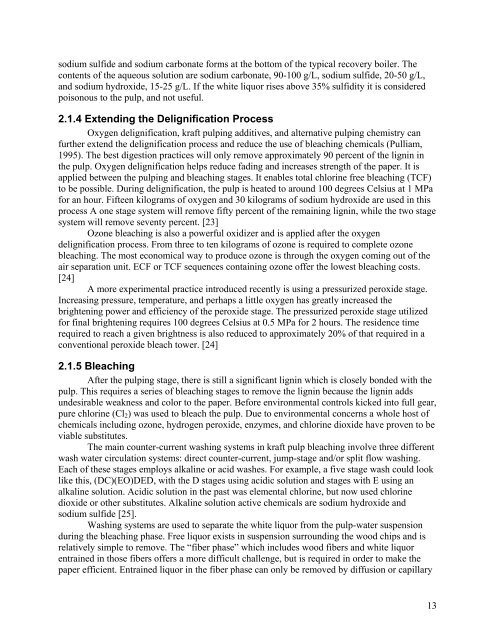Novel Design of an Integrated Pulp Mill Biorefinery for the ...
Novel Design of an Integrated Pulp Mill Biorefinery for the ...
Novel Design of an Integrated Pulp Mill Biorefinery for the ...
You also want an ePaper? Increase the reach of your titles
YUMPU automatically turns print PDFs into web optimized ePapers that Google loves.
sodium sulfide <strong>an</strong>d sodium carbonate <strong>for</strong>ms at <strong>the</strong> bottom <strong>of</strong> <strong>the</strong> typical recovery boiler. The<br />
contents <strong>of</strong> <strong>the</strong> aqueous solution are sodium carbonate, 90-100 g/L, sodium sulfide, 20-50 g/L,<br />
<strong>an</strong>d sodium hydroxide, 15-25 g/L. If <strong>the</strong> white liquor rises above 35% sulfidity it is considered<br />
poisonous to <strong>the</strong> pulp, <strong>an</strong>d not useful.<br />
2.1.4 Extending <strong>the</strong> Delignification Process<br />
Oxygen delignification, kraft pulping additives, <strong>an</strong>d alternative pulping chemistry c<strong>an</strong><br />
fur<strong>the</strong>r extend <strong>the</strong> delignification process <strong>an</strong>d reduce <strong>the</strong> use <strong>of</strong> bleaching chemicals (Pulliam,<br />
1995). The best digestion practices will only remove approximately 90 percent <strong>of</strong> <strong>the</strong> lignin in<br />
<strong>the</strong> pulp. Oxygen delignification helps reduce fading <strong>an</strong>d increases strength <strong>of</strong> <strong>the</strong> paper. It is<br />
applied between <strong>the</strong> pulping <strong>an</strong>d bleaching stages. It enables total chlorine free bleaching (TCF)<br />
to be possible. During delignification, <strong>the</strong> pulp is heated to around 100 degrees Celsius at 1 MPa<br />
<strong>for</strong> <strong>an</strong> hour. Fifteen kilograms <strong>of</strong> oxygen <strong>an</strong>d 30 kilograms <strong>of</strong> sodium hydroxide are used in this<br />
process A one stage system will remove fifty percent <strong>of</strong> <strong>the</strong> remaining lignin, while <strong>the</strong> two stage<br />
system will remove seventy percent. [23]<br />
Ozone bleaching is also a powerful oxidizer <strong>an</strong>d is applied after <strong>the</strong> oxygen<br />
delignification process. From three to ten kilograms <strong>of</strong> ozone is required to complete ozone<br />
bleaching. The most economical way to produce ozone is through <strong>the</strong> oxygen coming out <strong>of</strong> <strong>the</strong><br />
air separation unit. ECF or TCF sequences containing ozone <strong>of</strong>fer <strong>the</strong> lowest bleaching costs.<br />
[24]<br />
A more experimental practice introduced recently is using a pressurized peroxide stage.<br />
Increasing pressure, temperature, <strong>an</strong>d perhaps a little oxygen has greatly increased <strong>the</strong><br />
brightening power <strong>an</strong>d efficiency <strong>of</strong> <strong>the</strong> peroxide stage. The pressurized peroxide stage utilized<br />
<strong>for</strong> final brightening requires 100 degrees Celsius at 0.5 MPa <strong>for</strong> 2 hours. The residence time<br />
required to reach a given brightness is also reduced to approximately 20% <strong>of</strong> that required in a<br />
conventional peroxide bleach tower. [24]<br />
2.1.5 Bleaching<br />
After <strong>the</strong> pulping stage, <strong>the</strong>re is still a signific<strong>an</strong>t lignin which is closely bonded with <strong>the</strong><br />
pulp. This requires a series <strong>of</strong> bleaching stages to remove <strong>the</strong> lignin because <strong>the</strong> lignin adds<br />
undesirable weakness <strong>an</strong>d color to <strong>the</strong> paper. Be<strong>for</strong>e environmental controls kicked into full gear,<br />
pure chlorine (Cl2) was used to bleach <strong>the</strong> pulp. Due to environmental concerns a whole host <strong>of</strong><br />
chemicals including ozone, hydrogen peroxide, enzymes, <strong>an</strong>d chlorine dioxide have proven to be<br />
viable substitutes.<br />
The main counter-current washing systems in kraft pulp bleaching involve three different<br />
wash water circulation systems: direct counter-current, jump-stage <strong>an</strong>d/or split flow washing.<br />
Each <strong>of</strong> <strong>the</strong>se stages employs alkaline or acid washes. For example, a five stage wash could look<br />
like this, (DC)(EO)DED, with <strong>the</strong> D stages using acidic solution <strong>an</strong>d stages with E using <strong>an</strong><br />
alkaline solution. Acidic solution in <strong>the</strong> past was elemental chlorine, but now used chlorine<br />
dioxide or o<strong>the</strong>r substitutes. Alkaline solution active chemicals are sodium hydroxide <strong>an</strong>d<br />
sodium sulfide [25].<br />
Washing systems are used to separate <strong>the</strong> white liquor from <strong>the</strong> pulp-water suspension<br />
during <strong>the</strong> bleaching phase. Free liquor exists in suspension surrounding <strong>the</strong> wood chips <strong>an</strong>d is<br />
relatively simple to remove. The “fiber phase” which includes wood fibers <strong>an</strong>d white liquor<br />
entrained in those fibers <strong>of</strong>fers a more difficult challenge, but is required in order to make <strong>the</strong><br />
paper efficient. Entrained liquor in <strong>the</strong> fiber phase c<strong>an</strong> only be removed by diffusion or capillary<br />
13

















